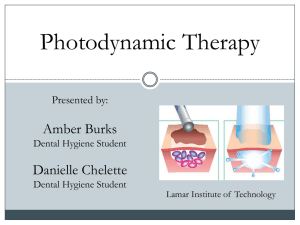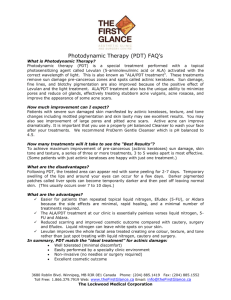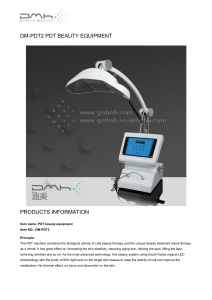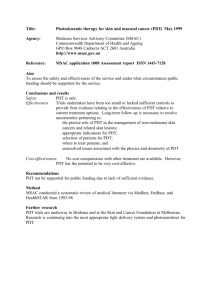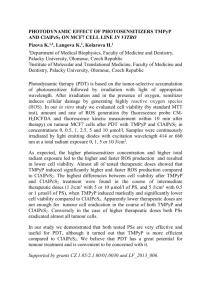Document 14233971
advertisement
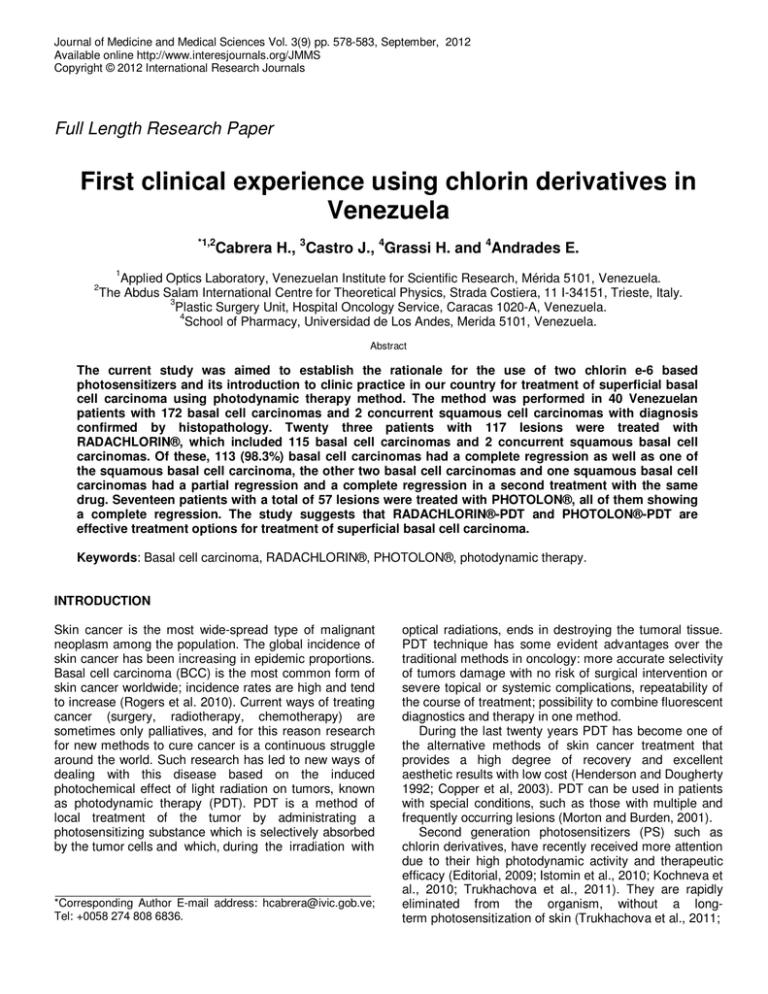
Journal of Medicine and Medical Sciences Vol. 3(9) pp. 578-583, September, 2012 Available online http://www.interesjournals.org/JMMS Copyright © 2012 International Research Journals Full Length Research Paper First clinical experience using chlorin derivatives in Venezuela *1,2 Cabrera H., 3Castro J., 4Grassi H. and 4Andrades E. 1 Applied Optics Laboratory, Venezuelan Institute for Scientific Research, Mérida 5101, Venezuela. The Abdus Salam International Centre for Theoretical Physics, Strada Costiera, 11 I-34151, Trieste, Italy. 3 Plastic Surgery Unit, Hospital Oncology Service, Caracas 1020-A, Venezuela. 4 School of Pharmacy, Universidad de Los Andes, Merida 5101, Venezuela. 2 Abstract The current study was aimed to establish the rationale for the use of two chlorin e-6 based photosensitizers and its introduction to clinic practice in our country for treatment of superficial basal cell carcinoma using photodynamic therapy method. The method was performed in 40 Venezuelan patients with 172 basal cell carcinomas and 2 concurrent squamous cell carcinomas with diagnosis confirmed by histopathology. Twenty three patients with 117 lesions were treated with RADACHLORIN®, which included 115 basal cell carcinomas and 2 concurrent squamous basal cell carcinomas. Of these, 113 (98.3%) basal cell carcinomas had a complete regression as well as one of the squamous basal cell carcinoma, the other two basal cell carcinomas and one squamous basal cell carcinomas had a partial regression and a complete regression in a second treatment with the same drug. Seventeen patients with a total of 57 lesions were treated with PHOTOLON®, all of them showing a complete regression. The study suggests that RADACHLORIN®-PDT and PHOTOLON®-PDT are effective treatment options for treatment of superficial basal cell carcinoma. Keywords: Basal cell carcinoma, RADACHLORIN®, PHOTOLON®, photodynamic therapy. INTRODUCTION Skin cancer is the most wide-spread type of malignant neoplasm among the population. The global incidence of skin cancer has been increasing in epidemic proportions. Basal cell carcinoma (BCC) is the most common form of skin cancer worldwide; incidence rates are high and tend to increase (Rogers et al. 2010). Current ways of treating cancer (surgery, radiotherapy, chemotherapy) are sometimes only palliatives, and for this reason research for new methods to cure cancer is a continuous struggle around the world. Such research has led to new ways of dealing with this disease based on the induced photochemical effect of light radiation on tumors, known as photodynamic therapy (PDT). PDT is a method of local treatment of the tumor by administrating a photosensitizing substance which is selectively absorbed by the tumor cells and which, during the irradiation with *Corresponding Author E-mail address: hcabrera@ivic.gob.ve; Tel: +0058 274 808 6836. optical radiations, ends in destroying the tumoral tissue. PDT technique has some evident advantages over the traditional methods in oncology: more accurate selectivity of tumors damage with no risk of surgical intervention or severe topical or systemic complications, repeatability of the course of treatment; possibility to combine fluorescent diagnostics and therapy in one method. During the last twenty years PDT has become one of the alternative methods of skin cancer treatment that provides a high degree of recovery and excellent aesthetic results with low cost (Henderson and Dougherty 1992; Copper et al, 2003). PDT can be used in patients with special conditions, such as those with multiple and frequently occurring lesions (Morton and Burden, 2001). Second generation photosensitizers (PS) such as chlorin derivatives, have recently received more attention due to their high photodynamic activity and therapeutic efficacy (Editorial, 2009; Istomin et al., 2010; Kochneva et al., 2010; Trukhachova et al., 2011). They are rapidly eliminated from the organism, without a longterm photosensitization of skin (Trukhachova et al., 2011; Cabrera et al. 579 Istomin et al., 2009; Cabrera et al., 2012; Chin et al., 2006; Allison and Sibata, 2010). This contributes in decreasing the long-lasting skin phototoxicity that is a main disadvantage of the first-generation PS (Moan, 1981). Some chlorin derivative PS are commercially available: RADACHLORIN® (produced by Rada-Pharma, Co. Ltd., Russia http://www.radapharma.ru/main) (Kochneva et al., 2010) and PHOTOLON® (produced by Scientific Pharmaceutical Center of RUE “Belmedpreparaty”, Minsk, Belarus http://belmedpreparaty.com/eng/photolon.htm) (Istomin et al, 2009; Isakau et al., 2008). Both are approved for use in PDT in the Russian Federation and in the Republic of Belarus. Photodynamic efficacy and safety of PDT with RADACHLORIN® and PHOTOLON® was proven within a number of clinical trials (Istomin et al., 2010; Kochneva et al., 2010; Trukhachova et al., 2011; Istomin et al., 2009). In 2010, clinical studies have shown that RADACHLORIN®-PDT had high anti-tumor activity with respect to all the specified forms of BCC of skin with 84.5% of complete regression in 84 patients treated (Kochneva et al., 2010). Istomin et al. have analyzed immediate and long-term results PDT with PHOTOLON® performed in 116 patients with BCC, and 16 patients with squamous cell carcinoma (SCC) of skin (Istomin et al., 2009). In 12 months after PDT a complete regression of tumors was achieved in 99 (85.4%) from 116 of patients with BCC of skin. Partial regression was observed in 2.6% of patients, and in 9.5% of cases stabilization of malignancies was observed. Thus, positive therapeutic effect was achieved in 113 (97.4%) from 116 patients. However, as has been stated, additional clinical studies are needed to evaluate their clinical potential for eventual use in other countries (Editorial, 2009). The purpose of the present study was to evaluate the therapeutic efficacy of the RADACHLORIN®-PDT and PHOTOLON®-PDT method for the treatment of multiple superficial BCC in Venezuelan patients, and to establish the rationale for the use of these photosensitizers and its introduction to clinic practice in our country. MATERIALS AND METHODS The present research was carried out at the Plastic Surgery Unit, Hospital Oncology Service, IVSS (former Hospital Oncologico “Padre Machado”), Caracas, Venezuela, with patients that attended the hospital facility and were found suitable for this study. Patients This study protocol was performed in 40 (20 male and 20 female) patients, ages 35-83 years with a total of 174 lesions, 172 BCC, and 2 concurrent SCC, on the head, neck, trunk, and lower extremities. Each patient was evaluated clinically and by histopathology before and after treatment. Informed consent was obtained from all patients, according to the approved protocol by the institutional Ethics Committee, and each patient was given specific instructions about photosensitivity and the precautions to be taken with light after treatment. The study protocol was also in agreement with the guidelines of the 1975 Declaration of Helsinki. The criteria for including patients were the following: a) Patients with histopathologic diagnosis of active lesions of skin (mostly BCC) in any clinical form, who were fit for surgical treatment. b) Patients with measurable lesions that could be studied histopathologically. c) Patients that could grant written consent to participate in the present study, preferably adults. The criteria for excluding patients were the following: a) Patients with demonstrated hypersensitivity to PS. b) Patients with other types of illnesses including oncologic diseases different from skin cancer. c) Patients that for any reason did not meet the requirements of the study. d) Patients with an estimated survival of less than three months. e) Patients that were pregnant women. Each patient was evaluated and classified by the Fitzpatrick criteria of skin types (Fitzpatrick, 1988), and each of the tumors was evaluated according to the TNM classification (American Joint Committee on Cancer, 2010). Photodynamic Therapy The treatment parameters were chosen on the basis of previous phase dose-ranging studies (Kochneva et al., 2010; Istomin et al., 2009). PDT was carried out with the PS RADACHLORIN® (23 patients) or with PHOTLON® (17 patients) using drug doses 1 mg/kg and 1.6 mg/kg body weight respectively, diluted in 200 cc of saline solution by intravenous injection slowly in a 20 minutes period. Patients were irradiated by the continuous diode laser (ML-662-SP, Russia) with 662 nm wavelength via optical fiber with light dose 250 J/cm2 (for RADACHLORIN®) and 200 J/cm2 (for PHOTOLON®), 2 and 3 hours after the drug injection, respectively. Before the procedure the shape and area of pathologic lesions were estimated by means of biopsy and conventional white-light. Tumors were irradiated one by one with a spot size which covered only the detected lesion. For larger tumors and those with a complex shape, the illumination was performed in several steps using partially overlapping, circular fields. Each treatment was conducted under proper shielding of the surrounding skin area and eye protection for both patients and medical personnel. 580 J. Med. Med. Sci. Figure 1. Number of patients as a function of sex and age groups, as follows: <50 (less than 50 years), <60 (50-59 years), <70 (60-69 years), <80 (70-79 years), <90 (80-89 years). PDT was performed under outpatient conditions and all patients were kept in sunlight-protected rooms from the time of drug administration until they leave the Hospital in the night, and all treated patients kept a restricted light regimen during the first 3 days after treatment. The effect of treatment was clinically evaluated by physicians (Jorge Castro and Nilyan Rincon) at different time intervals, as follows: a) during the first minutes, b) at six hours, c) at 24 hours, d) at 48 hours, e) at the first week, f) weekly for 8 weeks, g) every six months, h) at two year, when it was also examined by histopathology. Tumor response to the PDT was evaluated as: 1. Complete regression (CR): 100% tumor regression in clinical examination (i.e. visual examination) if there were no evidence of tumor and also by histopathology. 2. Partial regression (PR): decrease of maximal size of tumor not less than 50% 3. No regression (NR): decrease of maximal size of tumor less than 50% RESULTS A total of 174 lesions in 40 patients that complied with the inclusion criteria were referred by the physician after clinical examination, to be included in the PDT protocol. 23 patients (12 males and 11 females) with 117 lesions were treated with RADACHLORIN®, which included 115 BCC, and 2 concurrent SCC. Of these, 113 (98.3%) BCC had a complete regression as well as one of the SCC, the other two BCC lesions and one SCC had a partial regression and a complete regression in a second treatment with the same drug. The rest of the patients (17 patients, 8 males and 9 females with a total of 57 lesions) were treated with PHOTLON®, all of them showing a complete regression. Acceptable aesthetic results were reached in all these cases with minimal scar formation at treated zone. Among the included 40 patients (20 males with 90 lesions and 20 females with 84 lesions), 124 lesions (71.3%) were located on head and neck, 30 lesions (17.2%) were located on the trunck and 20 lesions (11.5%) were located on the extremities. Patients fall in the Fitzpatrick classification for Skin Types (Fitzpatrick, 1988), as follows: 6 (Type I), 16 (Type II), 9 (Type III) and 8 (Type IV). During the PDT treatment the procedure was well tolerable, only 9 patients required local anesthesia at the treated zone. Immediately after PDT treatment there was inflammation that disappeared after 3 days. A crusted ulcer formation appeared after 5 days and it disappeared 4 to 8 weeks later, with healing of the lesions. The patients´ condition has been followed up from 6 months to 2 year. In 48 months after PDT a complete regression of tumors was achieved in 113 (98.3%) from 117 treated lesions with RADACHLORIN®, and in the case of PHOTOLON® the complete regression was 100%. Figure 1 shows the distribution of patients by sex and by age groups, indicating that for the patients included in the PDT protocol, there were females in all the age groups under 80 years while males were only in a narrower category of age groups that ranged from 60 to 90 years. Also we found that the frequency of tumors was 5.05 for males and 4.15 for females, male gender and higher age have been found to represent risk factors for the development of BCC. Figure 2 shows the number of lesions that correspond to each skin type (Fitzpatrick, 1988), and tumor size (TNM-AJCC) (American Joint Committee on Cancer, 2010). The number of tumors type T1 was the highest among the patients in this protocol, with the highest number of lesions in skin type II (55 lesions). However, skin type II also had the highest number of patients (15 patients). Moreover, the frequency of lesions per patient in each skin type was 7(skin type I), 3.7(skin type II), 4.6 Cabrera et al. 581 Figure 2. Number of lesions as a function of Fitzpatrick classification of skin type (1 to 4 correspond to I to IV skin types) (Rogers et al., 2012) and TNM correspond to T0, T1, T2 and T3 of classification TNM-AJCC (Trukhachova et al., 2011). (a) (b) Figure 3 (a). 82-year-old man with multiple BCC before PHOTOLON®-PDT treatment (b). Crusted ulcer formation 10 days after treatment. (skin type III) and 4.5(skin type IV). Minimal signs of complications during or after treatment were registered: transient mild or moderate local pains at the treatment site (100% of cases), moderate edema and hyperemia during 2-3 days (90% of cases), followed by a crusted ulcer formation 4-5 days after PDT (100% of cases). There were no cases of allergic reactions after administration of PS. No skin phototoxicity was observed post PDT period. All treated patients kept a restricted light regimen 3 days after PDT. We have selected one representative case of this study. The patient that we present is a man that at the time of treatment was 82 years old, belonging to skin type II, whose photographic sequence documentation of the treatment of multiple BCC tumors is shown in Figure 3 ® and Figure 4. In this case the PHOTOLON -PDT treatment (drug dose 1.6 mg/kg body weight, light dose 2 200 J/cm ) was performed on three lesions (Figure 3a). Crusted ulcer formation occurred ten days after treatment (Figure 3b) and disappeared after 21 days (Figure 4a) 582 J. Med. Med. Sci. (a) (b) Figure 4 (a). Necrosis disappeared 21 days after PDT (b). Healing with cicatrization and epithelization 12 weeks after the treatment with gradual cicatrization and epithelization which was completed in 12 weeks (Figure 4b). The patient has been free of recurrence for 48 months. DISCUSSIONS In this study it was found that 73% of patients were more than 60 years old, in male gender the frequency for development of BCC was higher, and lesions were more frequently in head and neck. As the exposure to sun light is the main cause connected with this appearance, all these results are related with the accumulative effect of ultraviolet exposure, which produces Deoxyribonucleic Acid (DNA) modifications and therefore mutagenesis. Additionally the number of tumors type T1 is the most common with the highest number of lesions in skin type II. The average Venezuelan people are skin type II. In general, there were no recurrences or new lesions in 48 months follow up, and there were not differences in BCC treatment using RADACHLORIN® or PHOTOLON®, therefore both drugs were within the expected results. Our results, as others similar experimental and clinical studies (Istomin et al., 2010; Kochneva et al., 2010; Trukhachova et al., 2011; Istomin et al. 2009), have provided a convincing evidence that derivatives of chlorophyll a, in particular chlorin e6, are very promising compounds for treatment of skin malignancies, and particularly for their use in venezuelan clinical practice. CONCLUSIONS Complete regression of 98.3% was observed among the 23 patients treated with RADACHLORIN®, and 100% was achieved in patients treated with PHOTOLON®. Our data demonstrated that the ultraviolet exposure represent an important risk factor for development of BCC in Venezuelan patients. Both PS were well tolerable in patients with skin malignancies, thus concluding that PDT with this kind of PS is a relatively safe method for the treatment of BCC tumors. The results also demonstrated the effectivity of the method for treatment of multiple lesions. The present study correlate with the data of other authors by all main parameters: photosensitizer dosage, energy density and its total dose, clinical efficiency in complete and partial tumors regression. To our knowledge this is the first use of PHOTOLON®-PDT on patients in Latin American region. In general, obtained results showed the potential of this method for significant widespread of clinical applications of PDT with chlorin derivatives in our country. ACKNOWLEDGEMENTS The present work was supported by the Venezuelan Institute for Scientific Research (IVIC), Carretera Via Jaji, Km 29, Merida 5101, Venezuela, Tel. +58(274)8086836, and also by the “Abdus Salam” International Centre for Theoretical Physics (ICTP), Strada Costiera,11 I-34151, Trieste, Italy. REFERENCES Allison RR, Sibata CH (2010). Oncologic photodynamic therapy PSs: A clinical review. Photodiagnosis. Photodyn. Ther. 7: 61-75. American Joint Committee on Cancer (2010). Cutaneous squamous cell carcinoma and other cutaneous carcinomas. In: AJCC Cancer Staging Manual, 7th ed. New York, NY: Springer, 301–314. Cabrera H, Castro J, Grassi H C, Andrades EJ, Lopez-Rivera SA (2012). The Effect Photodynamic Therapy on Contiguous Untreated Tumor. Dermatol. Surg. 38: 1097-1099. Chin WWL, Paul PWS, Bhuvaneswari R, Lau WK, Olivo M (2006). The potential application of chlorin e6–polyvinylpyrrolidone formulation in photodynamic therapy. Photochem. Photobiol. Sci. 5 (11):1031– 1037. Copper MC, Bing TI, Oppelaar H, Ruevekamp MC, Stewart FA (2003). Cabrera et al. 583 Metatetra (hydroxyphenyl) chlorine photodynamic therapy in earlystage squamous cell carcinoma of the head and neck. Arch. Otolaryngol. Head Neck Surg. 129: 709–711. Editorial (2009). Chlorin e6-based PSs for photodynamic therapy and photodiagnosis. Photodiagnosis Photodyn Ther. 6: 94-96. Fitzpatrick TB (1988). The validity and practicality of sun-reactive skin types I through VI. Arch. Dermatol. 124: 869-871. Henderson BW, Dougherty TJ (1992). How does photodynamic therapy work?. Photochem. Photobiol. 55 (1): 145–157. Isakau HA, Parkhats MV, Knyukshto VN, Dzhagarov BM, Petrov EP, Petrov PT (2008). Toward understanding the high PDT efficacy of chlorin e6-polyvinylpyrrolidone formulations: photophysical and molecular aspects of PS—polymer interaction in vitro. J. Photochem. Photobiol. B 92 (3): 165-174. Istomin YP, Kaplanb MA, Shliakhtsin SV, Lapzevicha TP, Cercovskya DA, Marchankad LN, Fedulovd AS, Trukhachovac TV (2009). Immediate and long-term efficacy and safety of photodynamic therapy with Photolon® (Fotolon®) – a seven years clinical experience. Proc. of SPIE 7380: 73806V-1-8. Istomin YP, Lapzevich TP, Chalau VN, Shliakhtsin SV, Trukhachova TV (2010). Photodynamic therapy of cervical intraepithelial neoplasia grades II and III with Photolon®. Photodiagnosis Photodyn. Ther. 7: 144-151. Kochneva EV, Filonenkob EV, Vakulovskayac EG, Scherbakovad EG, Seliverstov OV, Markicheve NA, Reshetnickov AV (2010). Photosensitizer Radachlorin®: Skin cancer PDT phase II clinical trials. Photodiagnosis Photodyn. Ther. 7: 258-267. Moan J, Steen HB, Fehren K, Christensen T (1981). Uptake of hematoporphyrin derivative and sensitizer photoinactivation of C3H cells with different oncogenic potential. Canc Lett. 14: 291-296. Morton CA, Burden AD (2001). Treatment of multiple scalp basal cell carcinomas by photodynamic therapy. Clin. Exp. Dermatol. 26: 33-36. Rogers HW, Weinstock MA, Harris AR, Hinckley MR, Feldman SR, Fleischer AB, Coldiron BM (2010). Incidence estimate of nonmelanoma skin cancer in the United States. 2006, Arch. Dermatol. 146 (3): 283-287. Trukhachova TV, Shliakhtsin SV, Cerkovsky DA, Istomin YP (2011). A novel finished formulation of the photosensitizer Photolon® for topical application. Evaluation of the efficacy in patients with basal-cell carcinoma of the skin. Photodiagnosis Photodyn. Ther. 8: 200-201.
